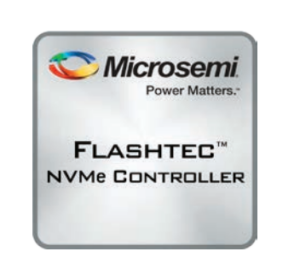 Microsemi Corporation today announced the availability of its mainstream Flashtec NVM Express (NVMe)2108 eight channel and NVMe2104 four channel controllers, enabling leading enterprises and data centers worldwide to realize cost and power effective high capacity solid state drives (SSDs). The second generation PCIe devices extend Microsemi’s product line to mainstream capacity, performance, and power while maintaining architectural consistency and attractive enterprise features from its current controllers.
Microsemi Corporation today announced the availability of its mainstream Flashtec NVM Express (NVMe)2108 eight channel and NVMe2104 four channel controllers, enabling leading enterprises and data centers worldwide to realize cost and power effective high capacity solid state drives (SSDs). The second generation PCIe devices extend Microsemi’s product line to mainstream capacity, performance, and power while maintaining architectural consistency and attractive enterprise features from its current controllers.
“Our new Flashtec NVMe2108 and NVMe2104 controllers are the latest offerings demonstrating Microsemi’s multi-generational expertise in delivering PCIe NVMe SSD controller products for enterprise, server, and data center markets,” said Derek Dicker, vice president and business unit manager, performance storage, at Microsemi. “These new controllers provide the balance of the same enterprise-grade features and a mature enterprise architecture customers have come to expect from us, with lower power and cost structure aligned with the mainstream PCIe segment’s U.2 and M.2 needs.”
According to market research firm IDC’s report titled, “Worldwide Solid State Drive Forecast, 2015–2019,” the industry is transitioning toward PCIe-based SSDs, with PCIe-based SSDs estimated to be more than 40 percent of enterprise SSD revenue by 2019. Microsemi’s full portfolio of second-generation PCIe controllers cater to this growing demand. The company’s two new devices offer eight and four channel PCIe NVMe controllers capable of supporting capacities of greater than 7 TB, a DDR4 interface capable of supporting 8 GB and higher, dual-port, SRIS, end-end data protection and M.2 form factor support using the four channel product.
In addition, the new devices enable reuse of firmware with existing Microsemi NVMe controller customers, expanding support and making design cycles shorter. The new Flashtec NVMe2108 and NVMe2104 controllers are optimized for leading mainstream read/write performance. Since the controller performs all flash management operations on-chip and consumes negligible host processing and memory resources, it can also be used by customers for host-based Flash Translation Layer (FTL) implementations.
Key features include:
- Extending the current controller architecture to mainstream eight and four channel PCIe Flash controllers for enterprise and data center markets
- Support for greater than 8GB of DDR4 using standard components
- Eight channel optimized for U.2 and half-height half-length (HHHL), while the four channels can also support M.2 form factors
- Mature architecture with optimized power and cost for mainstream, while preserving enterprise features like dual-port, SRIS and end-end data protection
- Advanced ECC enables support of current and future generations of Toggle and ONFI NAND
- Programmable architecture enables SSD product differentiation through firmware customizations

Leave a Reply